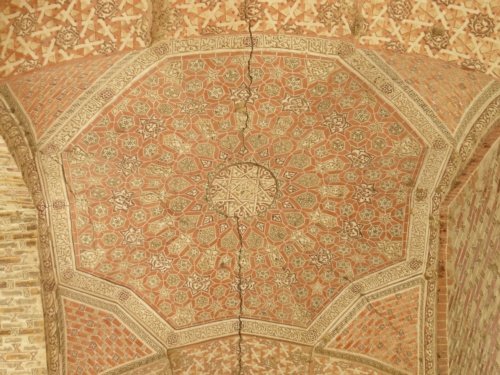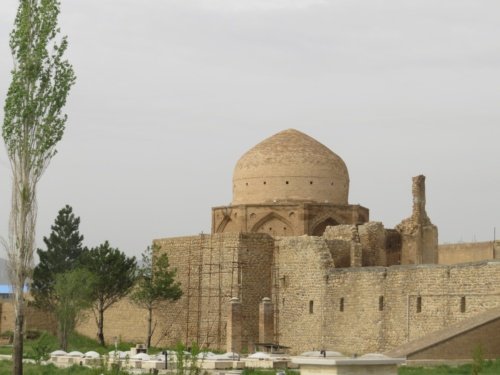Els Slots
WHS #602: Soltaniyeh
This nomination carried the Epic Subtitle “Dome of Soltaniyeh; the pasture which became the capital city of the empire”. Unfortunately it was not brought forward to the inscription, now the name of this WHS is a simple Soltaniyeh . The original title though hinted at the Mongol origins of the site: this is the best representation of the heritage of the Mongolian Ilkhanids among Iran’s WHS, although the newer parts of Takht-e Soleyman and the Blue Mosque of Tabriz also date from this era (13th-14th century).

|
| Model of a complete mausoleum of Öljaitü |
The famous Dome of Soltaniyeh can already be seen from miles away. The light-turquoise structure on top of a 50 meter high octagonal building still towers above everything in its surroundings, including the current town of some 6,000 souls. This is a very flat landscape, the Mongolians are said to have chosen this spot to settle because of the vast pastures it provided for their horses.
The building was made to house the mausoleum of Ilkhanid khan Öljeitü. Its interior at the moment is fully covered in scaffolding, therefore unfortunately it is impossible to see anything of the inner construction of the dome. This repair work has been going on for a long time already, apparently since 1994. The ongoing restoration prompted me to look at the Management Plan which Iran submitted with the nomination. The 1-, 3- and 5-year action plans seem to be detailed. However only a budget of 300,000 dollars a year was available, from which they also have to pay the regular upkeep of the site (electricity bill, salaries etc). Through annual projects the Iranian state provides for the costly maintenance of the monument. They started the restoration with replacing the missing tiles on the outside of the dome. Now they take on the interior.

|
| Geometrical patterns of specially cut brick |
One can climb the stairs to the second and third floors, and walk around in the galleries on the outside of the building. This is enough to see the the remarkable decoration of the structure. There are some ubiquituous blue tiles of course, but also stucco design and intricate brick work. Just as at many other sites that I visited in Iran, earthquakes have also here led to many cracks in the walls and ceilings.
In the vicinity of Öljeitü’s mausoleum there are 13 other sites that belong to this WHS. Our tour group made a short coffee stop (picknick-style, with our own packed ingredients) at one of them: Chelebi Oghlu. This is also a mausoleum, built at the same time as the large mausoleum of Soltaniyeh. A Sufi saint lies buried here, and a Sufi shrine developed in this place. Not a spectacular sight, but enough to remind you that this site once covered a capital city of an empire.

|
| Chelebi Oghlu |
A nice bit of trivia about Soltaniyeh is that khan Öljeitü, who lies buried here, was a bit shaky in his religious beliefs. He was baptized as a Christian, and took the name ‘Nicholas’. Afterwards he dabbled in Buddhism and Sunni Islam, before finally choosing Shia Islam (and changing his name to Muhammad). He suddenly was so sure of this road that he planned to transfer the bodies of Imam Ali and Imam Husayn from their resting places in Karbala , Iraq (the holiest site in Shia Islam after Mecca and Medina) to Soltaniyeh. Maybe unfortunately for the current Islamic Republic of Iran, this did not materialize.
More on
Els SlotsComments
No comments yet.
